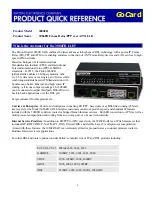
215
Step Command
Remarks
11.
Associate the class with the
behavior.
classifier
tcl-name
behavior
behavior-name
Repeat this step to create other
class-behavior associations.
Configuring the customer-side port
Step Command
Remarks
1.
Enter system view.
system-view
N/A
2.
Enter interface view or port
group view.
•
Enter Layer 2 Ethernet interface
view:
interface
interface-type
interface-number
•
Enter port group view:
port-group manual
port-group-name
N/A
3.
Configure the link type of the
port.
•
Configure the port as a trunk
port:
port link-type
trunk
•
Configure the port as a hybrid
port:
port link-type hybrid
Use one of the commands.
The default link type of an Ethernet
port is access.
4.
Assign the port to all SVLANs.
•
Assign the trunk port to VLANs:
port trunk permit vlan
{
vlan-list
|
all
}
•
Assign the hybrid port to VLANs
as a tagged member:
port hybrid
vlan
vlan-list
tagged
Use one of the commands.
By default:
•
A trunk port is assigned only to
VLAN 1.
•
A hybrid port is an untagged
member of VLAN 1.
5.
Apply the uplink policy
configured for the
customer-side port to
incoming traffic.
qos apply policy
policy-name
inbound
N/A
6.
Apply the downlink policy
configured for the
customer-side port to outgoing
traffic.
qos apply policy
policy-name
outbound
N/A
Configuring the network-side port
Step Command
Remarks
1.
Enter system view.
system-view
N/A
2.
Enter interface view or port
group view.
•
Enter Layer 2 Ethernet interface
view:
interface
interface-type
interface-number
•
Enter port group view:
port-group manual
port-group-name
N/A
















































